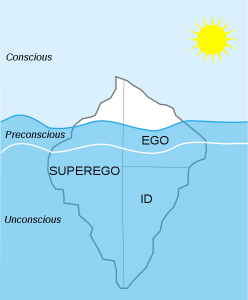When you are aware of your physical or emotional sensations, you are using your conscious mind; thinking, planning, focusing, analyzing, studying or making choices are all things that you do (mostly) consciously.
A lot of our inner activity, though, goes on in the unconscious. Freud was the first European to bring the unconscious mind to the attention of society. He posited that our full  consciousness was like an iceberg: we could only see the tip of the iceberg (our conscious mind), and most of the iceberg (our unconscious) was hidden beneath the water. At the waterline, the part of the iceberg that moved in and out of the water, he termed the preconscious; that’s where we keep information that we need to have handy, but not in the forefront of our mind, such as PIN numbers, passwords, or our address. The preconscious is also where our Ego mediates between the unconscious desire to have our selfish human needs met immediately (the Id) and our internalized societal demands to be good (the Superego).
consciousness was like an iceberg: we could only see the tip of the iceberg (our conscious mind), and most of the iceberg (our unconscious) was hidden beneath the water. At the waterline, the part of the iceberg that moved in and out of the water, he termed the preconscious; that’s where we keep information that we need to have handy, but not in the forefront of our mind, such as PIN numbers, passwords, or our address. The preconscious is also where our Ego mediates between the unconscious desire to have our selfish human needs met immediately (the Id) and our internalized societal demands to be good (the Superego).
Freud’s theory also recognized that our conscious mind uses words and thinking, and that the Unconscious uses imagery, metaphor, and symbols to communicate.
Carl Jung took Freud’s ideas further, to expand the idea of the Unconscious to include the concept of the Collective Unconscious, which we all share as human beings on this planet.
